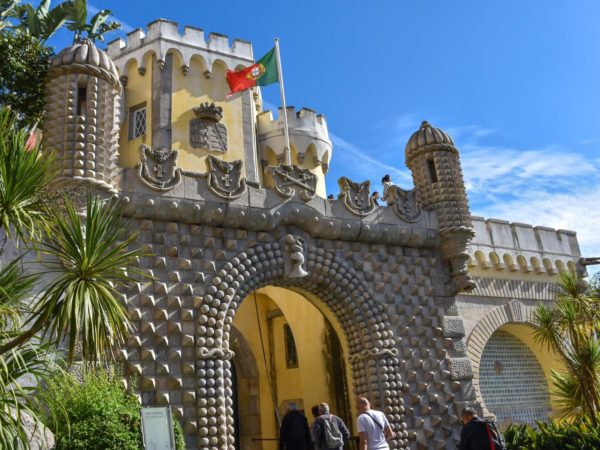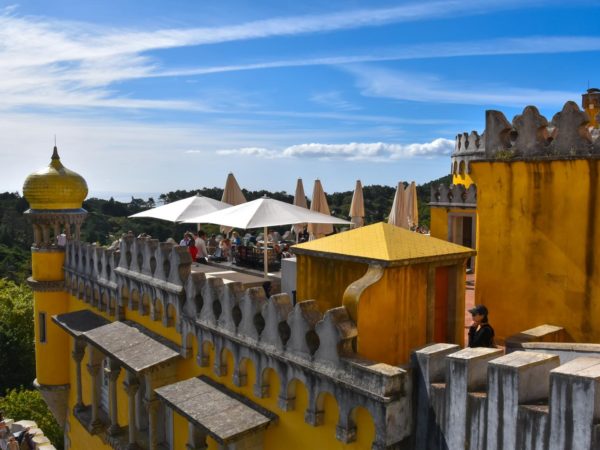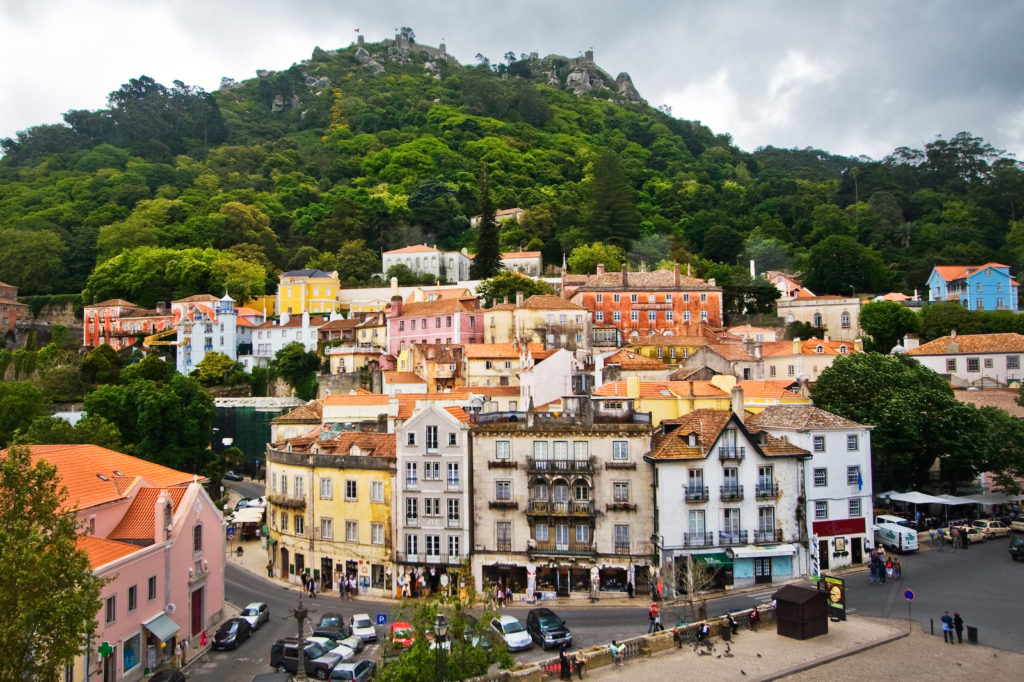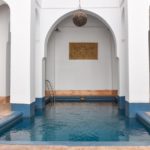 Leaving Lisbon and going to Sintra feels like going to another world. Sintra is located outside of Lisbon in the hills of Serra de Sintra and aside from being a Unesco world Heritage site, it’s filled with beautiful palaces and manors, gorgeous gardens, historical fortifications and great food. It’s a must visit if you’re in Lisbon. Plus, it’s only a 45 minute train ride from Lisbon.
Leaving Lisbon and going to Sintra feels like going to another world. Sintra is located outside of Lisbon in the hills of Serra de Sintra and aside from being a Unesco world Heritage site, it’s filled with beautiful palaces and manors, gorgeous gardens, historical fortifications and great food. It’s a must visit if you’re in Lisbon. Plus, it’s only a 45 minute train ride from Lisbon.
Here are some of our favorite things to do and see in Sintra.
1. Palacio National De Pena (Pena Palace)
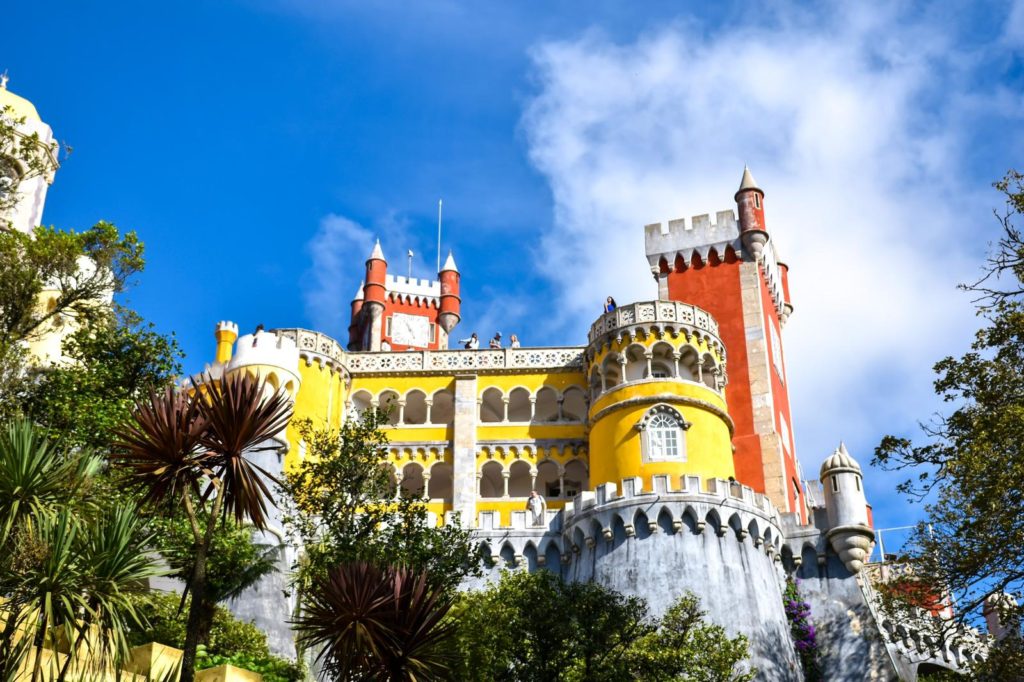
I absolutely love castles and it just so happens that Sintra has one of the most beautiful palaces in the world.
Pena Palace is one of the most notable examples of Portuguese architecture in the Romantic period. It sits on the peak of Serra de (Mountain of) Sintra and looks like a castle out of a fairytale.
It began as a Monestarry in the 1400s and was ultimately destroyed in an the earthquake in 1755. It was then purchased by King Ferdinand, rebuilt and later became a summer home for the Royal family.
The palace itself boasts beautiful towers, terraces, and stunning views. There’s a beautiful colorful terrace (Relogio De Sol) where you can view breathtaking views over the Sintra region. You’ll also see gorgeous statues, elegant staterooms, artifacts from the time period and much more.
The palace can get busy during peak travel season, so try to visit as early (or late) in the day as possible. I would recommend catching the 434 bus up to the palace, which is about a 15 minute ride from the city center of Sintra.
2. Castelo dos Mouros (Castle of The Moors)
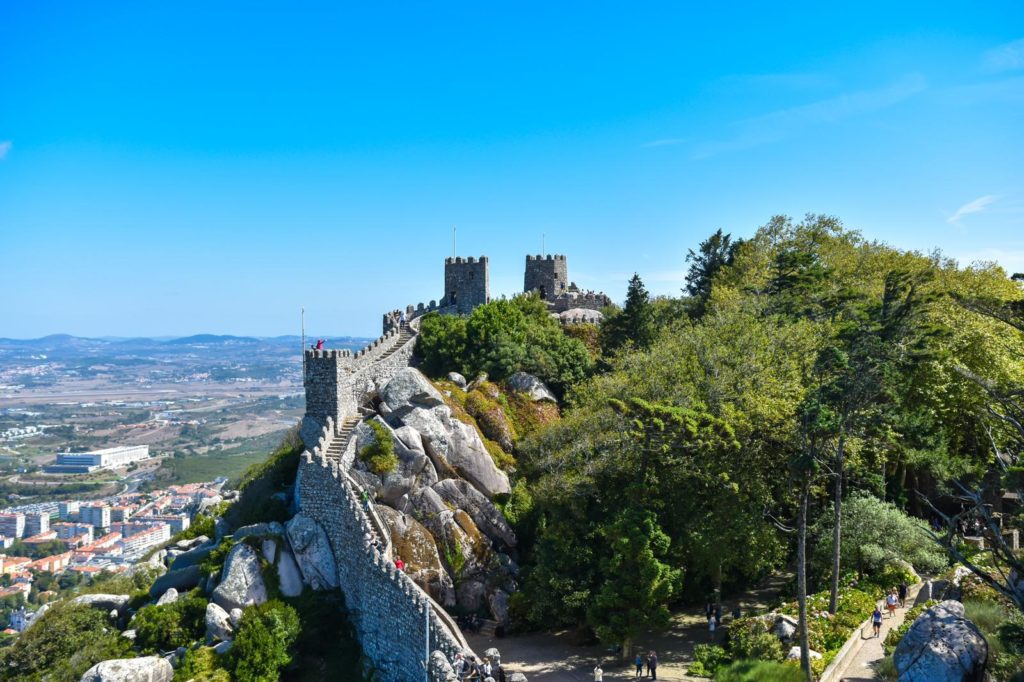
The Castelo dos Mouros was constructed by the Moors in the 8th and 9th century on a vantage point, high above Sintra. It provided the Moors a strategic lookout point along the coastline and surrounding lands.
The castile was taken by Christians during the crusades in 1147 and later served as a means to defend the surrounding lands. Today, the fortress is impossible to miss from every angle in town of Sintra below.
Inside you’ll see ancient battlements, climb the defensive towers, but to me, the best part of the castle are the stunning panoramic views of Sintra, the Palace of Pena, and, in the distance, the green hills contrasting with the blues of the Atlantic Ocean.
The Castelo Dos Mouros is only 200m from the Pena Palace so you can easily walk from one to the other. If you’re coming from town, however, the best way to reach the castle from Sintra is to catch the 434 tourist bus.
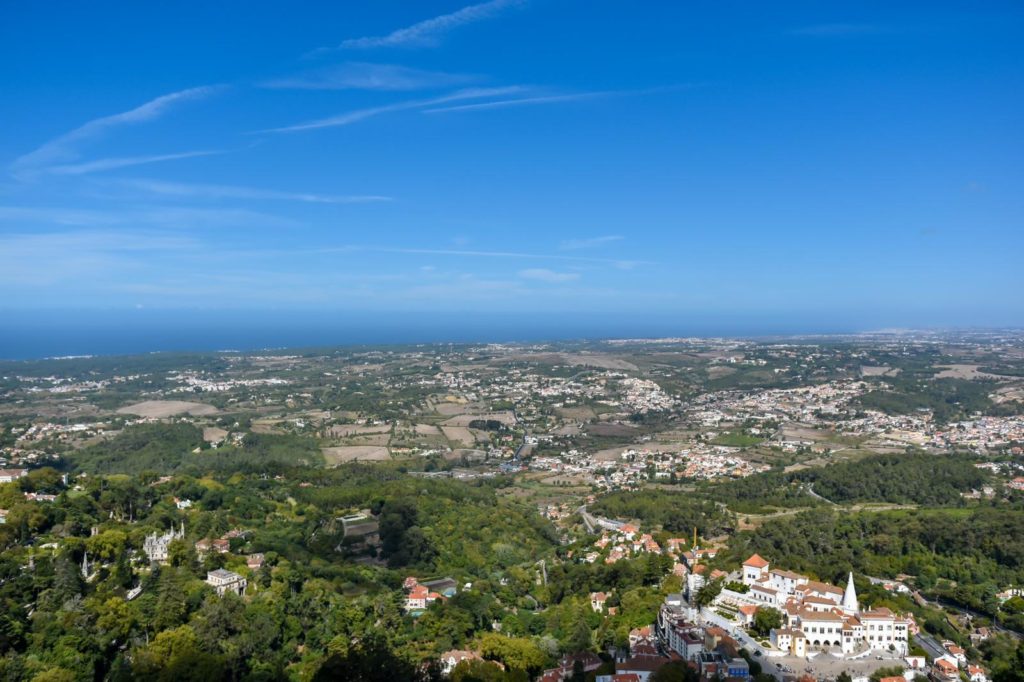
Views From The Castle Of The Moors
3. Explore the Quinta da Regaleira
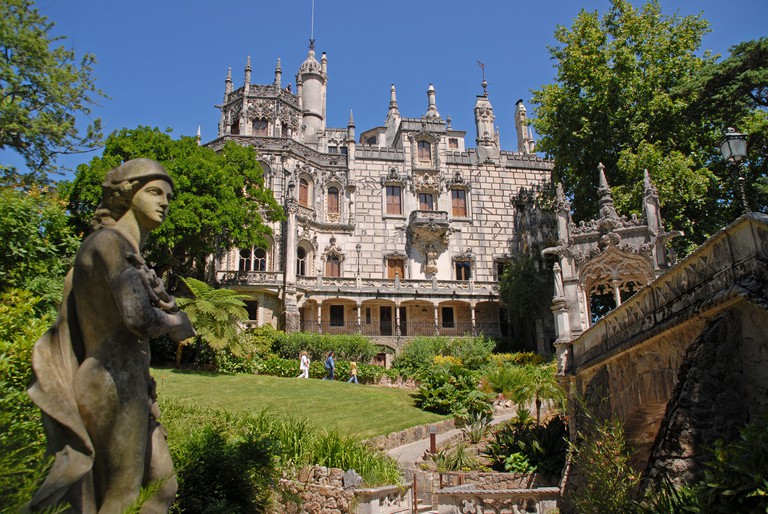
The Quinta da Regaleira is a gothic architectural masterpiece that served as the private residence to many owners, including the Viscountess of Regaleira (a merchant family from Northern Portugal). Another owner, António Augusto Carvalho Monteiro, is responsible for the many items and monuments reflecting his fascination with the Mason’s, Knights Templar and Divination.
His Romantic palace is out of a dream and bursts with Manueline-style masonry, but it’s in the palace park where Monteiro’s eccentric personality comes through: Underground there’s a system of tunnels and grottoes, all intended to confuse and delight.
Above are ornate gazebos, benches with sculptures and two “initiation wells”, one of the most popular places to take a photo in Sintra.
4. Visit the Parque De Pena
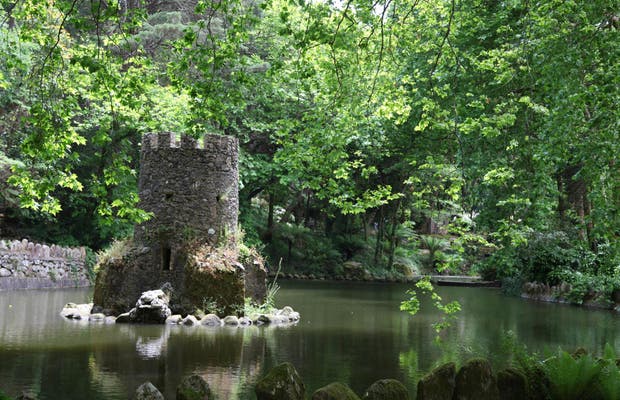
Part of exploring the Pena Palace includes walking around the grounds. The forested walkways cover 494 acres of land and showcase thousands of floral species, as King Ferfinand II had trees imported from all over the world to be planted here.
5. Cruz Alta
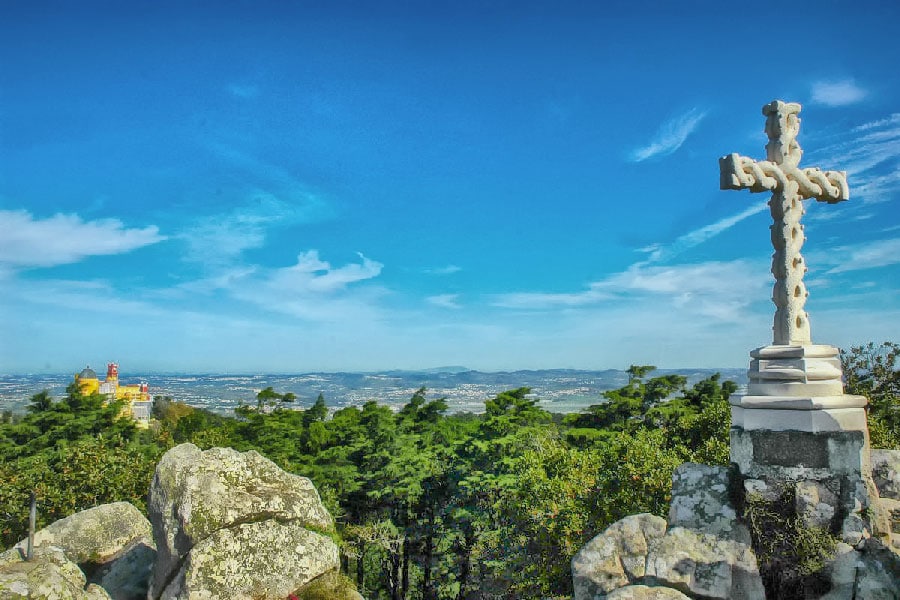
One of the best parts of walking through Pena Park is following the trail that leads to The Cruz Alta. It’s the highest point in the Serra de Sintra at 529 meters high.
The panoramic views from the spot are indescribable. From the gorgeous landscape of the mountains, the entire Sintra town hall below, the beautiful Tejo estuary, and the vast Atlantic Ocean, you’re sure to continuously be amazed. You can even see Lisbon on a clear day.
My favorite view from this spot is the perspective of the nearby colorful Pena Palace contrasted with the gray and green of the surround Sintra mountains.
6. The Palace of Monserrate
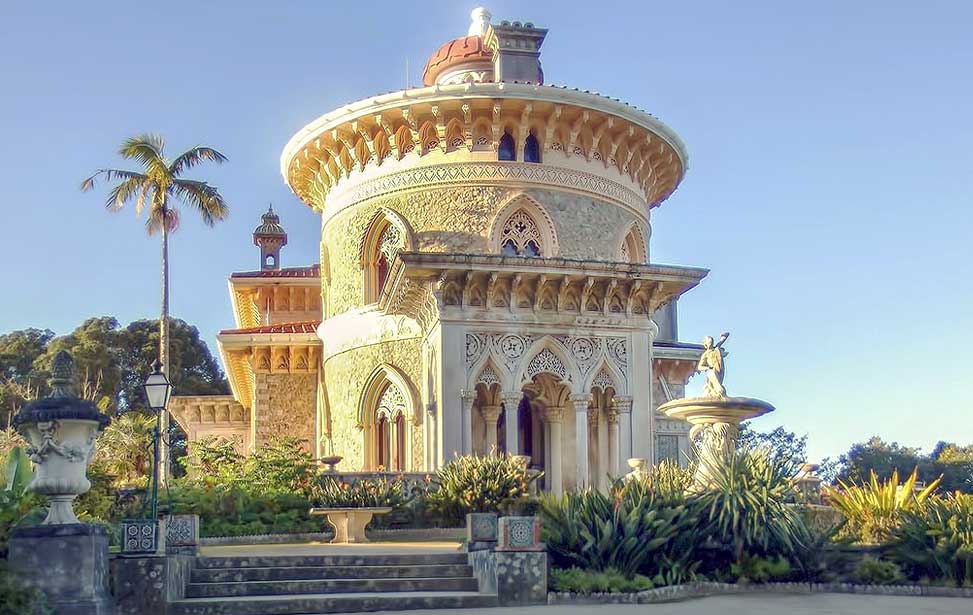
Once a summer home for Portuguese royalty, the Monserrate Palace is a 19th-century mansion with Anglo-Saxon, Indian and Arab architectural influences.
It was all landscaped in the mid-19th century for Sir Francis Cook, an English aristocrat who was given the title Viscount of Monserrate by King Luís I.
On the palace grounds you’ll find a park with bamboo plantations, grottoes, man-made waterfalls, ponds, exotic cedars and Oceanic tree ferns.
As for the residence, the Islamic influence is undeniable, in the latticework in its arches, the arabesque stucco patterns on the stairway and the ceiling of the radiant music room, which still hosts concerts to this day.
The estate also contains a botanical garden, which is a perfect location to sit and rest after a day of walking from palace to palace.
7. Eat Delicious Seafood
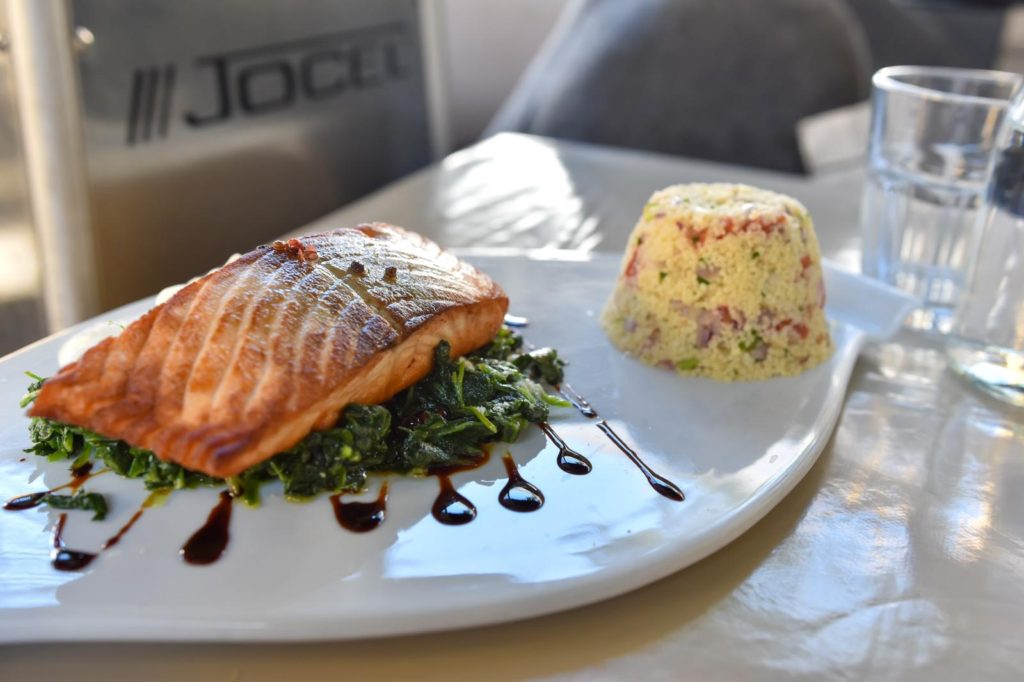
Portugal is renowned for its delicious seafood but Sintra has some of the country’s finest and at much more reasonable rates than in other parts of the country.
You can try percebes, their local delicacy a try. There are also a number of other delicious fresh fish dishes that have been caught just hours before that are worth sampling.
8. Cabo Da Roca
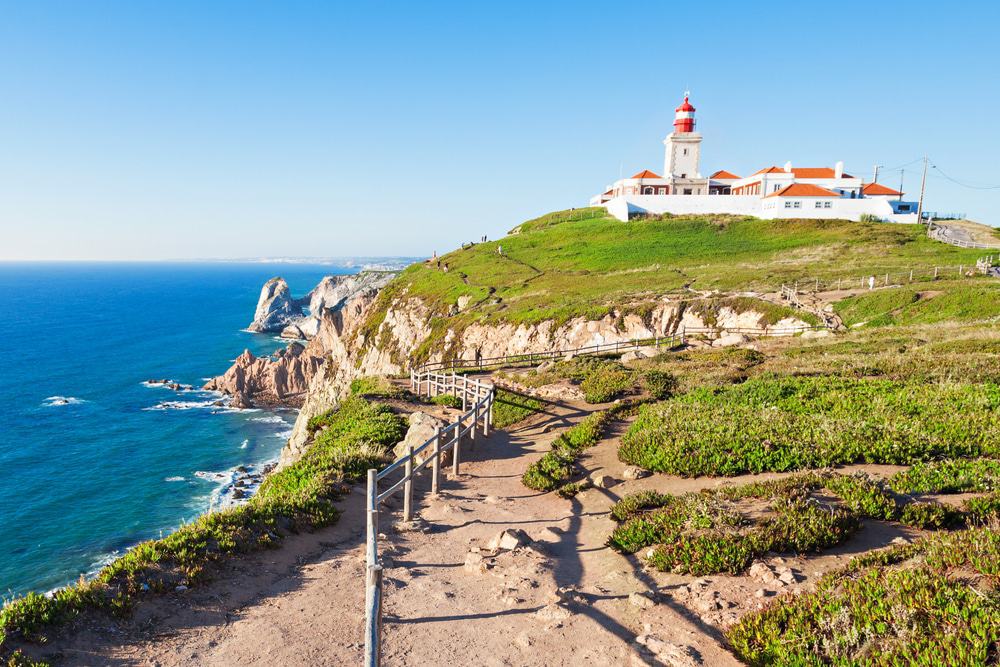
Hop in a taxi or bus and you can soon be at Cabo Da Roca, the westernmost point in mainland Europe. It’s also the point where the Serra de Sintra sinks dramatically into the ocean.
The cape is 140 meters high and sits a top a granite cliff. It’s the perfect spot to take photos with nearly 360 degree views along the coast.
There, you’ll also find a lighthouse, as well as a stone monolith with a cross to mark this headland, which was a famous seamark from Roman times to the Age of Discovery.
9. Visit The Palace of Sintra
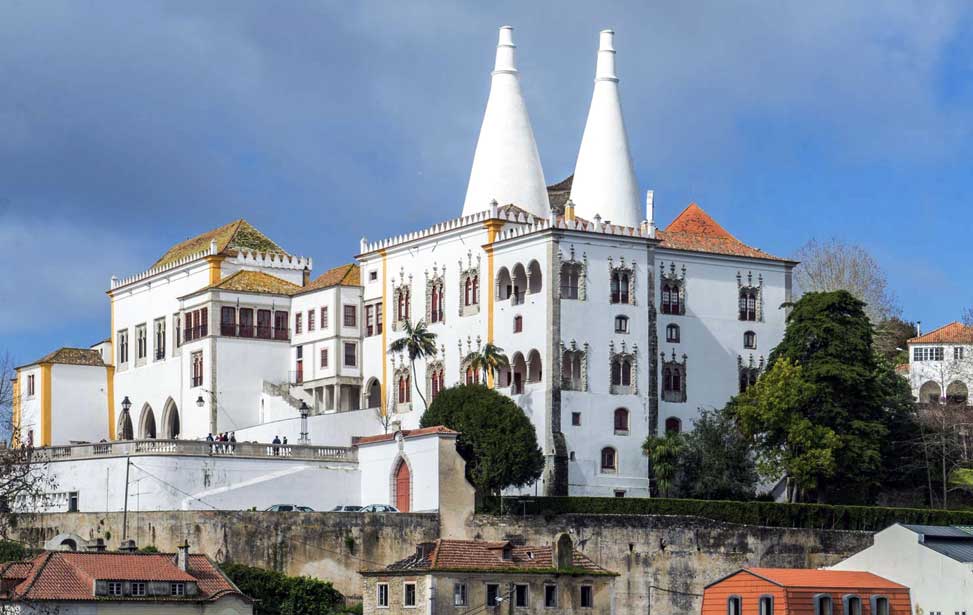
The National Palace of Sintra is recognized as the best example of preserved medieval palaces in the country.
You’ll know this palace right away for its pair of white conical towers above a mishmash of halls and annexes.
Built in the 15th century, it’s the oldest palace in the town and served as the royal residence of Portugal’s nobility for four centuries, with each successive occupant added a bit of their own personality.
You can tour this palace and see beautifully preserved furniture and ancient decorative styles. It’s also worth checking out the magnificent Sala dos Brasões (Coats of Arms Hall), where the coffered ceiling sports the 72 coats of arms of the Portuguese royalty and nobility.
10. Praia das Maçãs
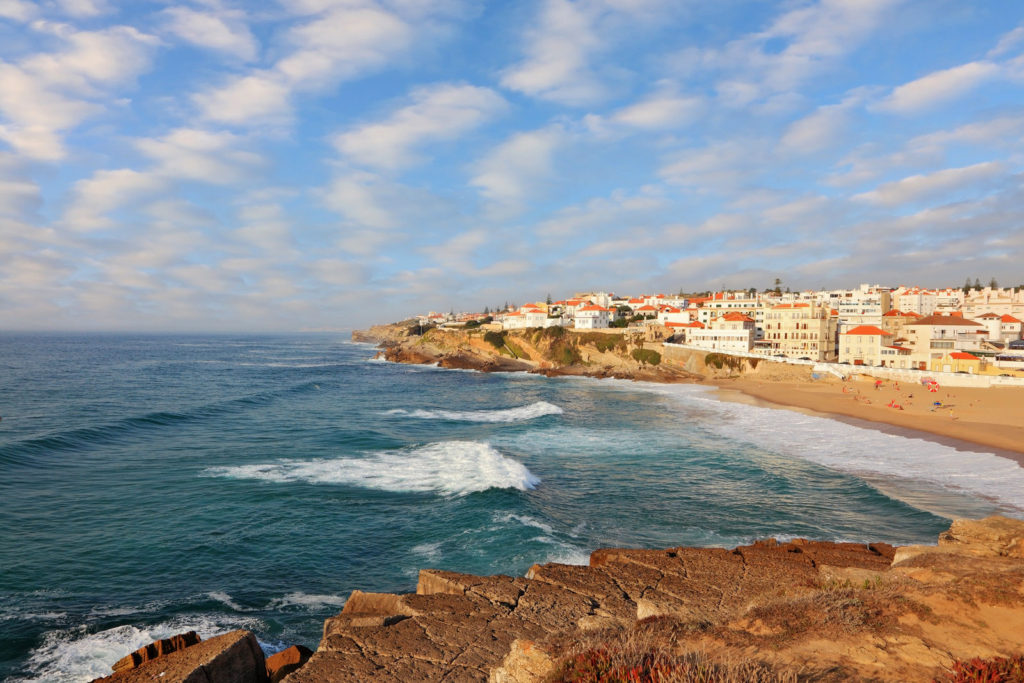
The Praia das Maçãs is one of the most popular beaches not too far from Lisbon. It’s a great spot for catching sea and sun and can easily be reached from Sintra via tram.
Being on the Atlantic coast the waves can be powerful here, but there are also saltwater pools on site, equipped with slides, diving boards and a kid’s pool right on the beach.
11. Azenhas do Mar
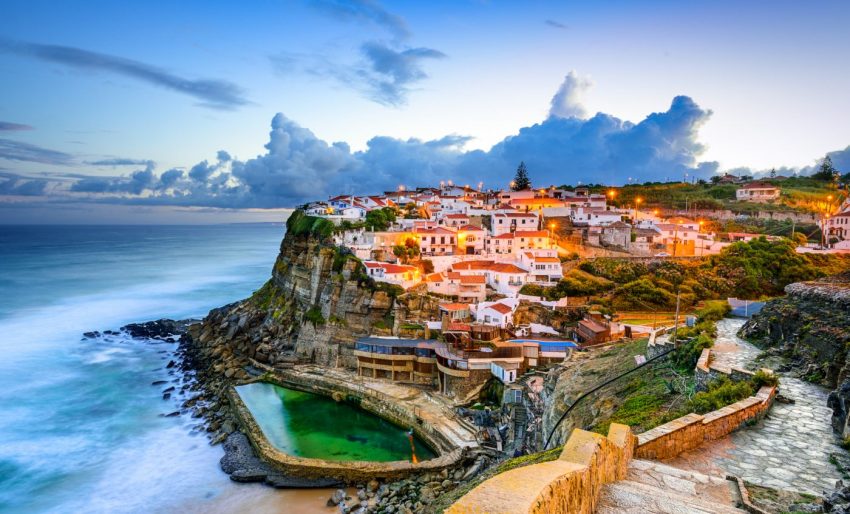
Just outside of Sintra’s town center is Azenhas do Mar, a beautiful village nestled between the sea and the mountains. Cradled against the seaside, it’s known for its namesake beachside venue that offers diners breathtaking views.
Here you’ll also find good wines, fresh and delicious seafood, and other local dishes at a modest price. Stay late and plan to catch a beautiful sunset after dinner.
12. Casa Piriquita

If you have a sweet tooth like me, you can’t leave Sintra without stopping by Casa Piriquita and tasting some of their sweets. This historic cafe and pastry shop is 155 years old and located in the town center.
One treat that is almost exclusive to Sintra is the queijada, a small circular cake, made with eggs, milk, sugar, and cheese. Give this a try or the almond-flavored (and topped) travesseiro. You’ll be glad you did.
It’s usually pretty busy so the best time to go is after breakfast and before lunch (between 11 and noon). Also, you can always take your pastries to go.
13. Palácio Nacional e Jardins de Queluz
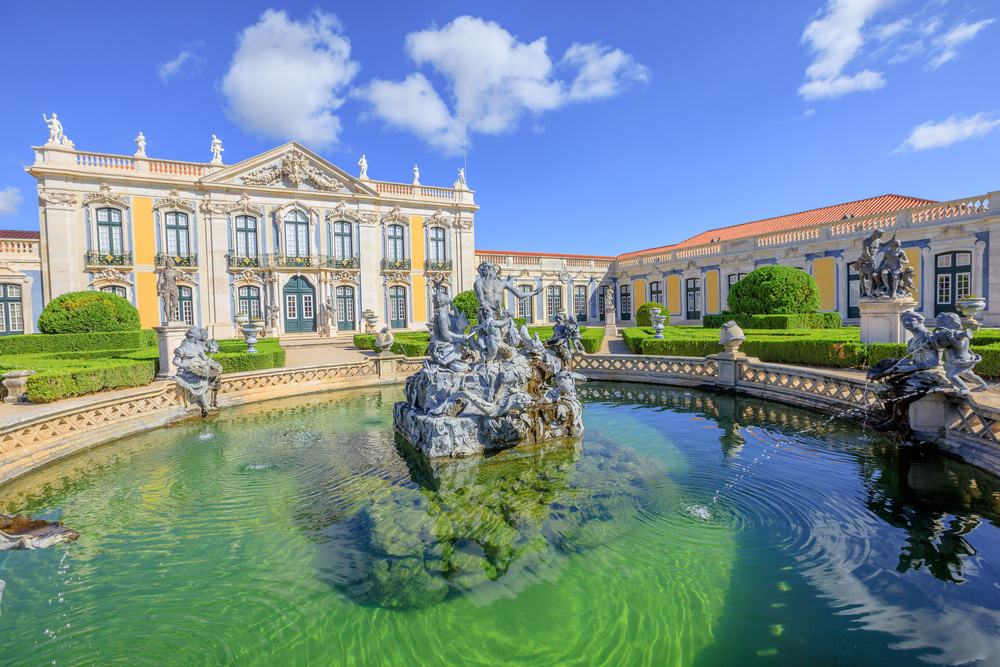
Queluz is a city east of Sintra, but in the same municipality.
The thing to see is the Palace of Queluz, which took shape in the middle of the 18th century and has exuberant Rococo architecture.
It was the summer retreat of Dom Pedro of Braganza, who would become King Consort to his own niece, Queen Maria I. The interiors are sublime, festooned with gilded stuccowork and resplendent frescos on the ceiling in the Music Room and the Queen’s Boudoir where there’s a dainty trellis pattern.
Outside you can savour the Baroque grandeur of French architect Jean-Baptiste Robillon’s facades, and the 100-metre canal, which is walled by blue and white tile panels.
14. Praia da Ursa
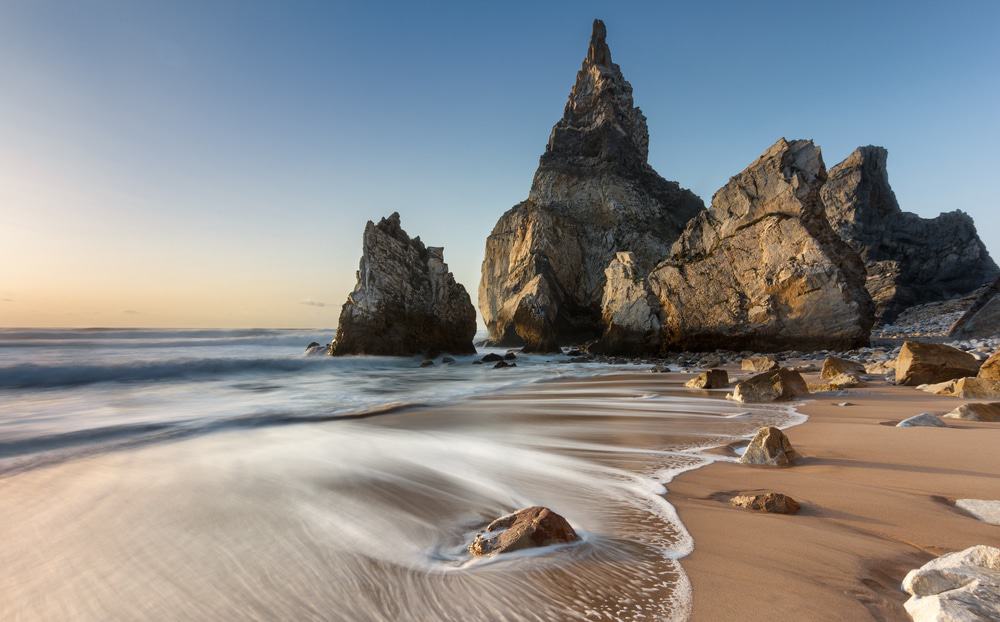
It’s a sign of the high standard of the beaches in Sintra that the second best beach in the town is still held as one of the best in all of Portugal.
Adraga is the next one up from Praia da Ursa, and has the same sharp rocks and intimidating wall of cliffs behind.
The good news is that you can drive down, and there’s a restaurant by the car park next to the beach.
If you go carefully it’s a fun place to explore, adventuring over the rocks to find caves and tunnels.
The surf is a bit more vigorous at this beach than its neighbour, but there is a lifeguard all summer.
15. Explore The Historic City Center
Positioned along the foothills of the Sintra Mountains and overlooked by the Castle of the Moors, the city center of Sintra has a lot to offer. Classified as a UNESCO World Heritage Site in 1995, the cultural landscape of Sintra is known for its fairy-tale 19th-century romantic architecture, palaces, pastel coloured villas, and sweeping views.
Get lost in the winding narrow streets, which are full of cafes, souvenir stores, and boutiques selling a range of artisan items.
Getting To Sintra
The best way to travel to Sintra from Lisbon is by train. There are two train services that depart from Lisbon. The majority of visitors depart from Rossio station, as it’s close to popular tourist areas. This is the train that we took.
The Lisbon-Sintra train route is about 40 minutes. A one-way costs 2.25 euro and round trip costs 4.50. Trains depart approximately every 30 minutes, with services starting early in the day and continuing until late at night.

Geron is an avid traveler, entreprenuer and mens style aficionado. He love’s mac and cheese, getting discounts, his momma, and a good whiskey, not particularly in that order. It’s alleged he lives in Miami, but no one really knows anymore.
Follow him on instagram at @geronp
